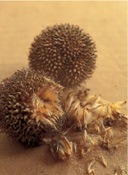
TO LB

Note: Many of the procedures described in this book involve sharp instruments. Please follow all instructions carefully and take all necessary precautions when using these instruments. Also, wear gloves when handling plant parts that are not well known to you and always wash hands thoroughly before eating or drinking. Contact with some plants may cause irritation, and many have toxic components, if consumed. Some plants may cause allergic reactions in some people.
Note on the photography: The majority of the photographs in this book were taken with a Mamiya 6/4.5 camera. Fujichrome Velvia (RVS) was the film stock used for most of the pictures. Additional film stocks included Kodak Ektachrome EPP, VSW and Fujichrome RAS. Several of the photographs are double exposures. None of the pictures were manipulated by computer or digitally altered after processing. Most of the hands in the book are the author’s taken with a nonmechanical cable shutter-release.
A tall, sunset-colored dahlia finds its way back to the garden each year from divisions of stored tubers. The unnamed selection was plucked from a batch of mixed seedlings. Louis Bauer holds two boxwood plants that were taken as semi-ripewood cuttings and rooted over winter. The dry fruits of the American sycamore (Plantanus occidentalis). The sycamore was one parent of the ubiquitous urban tree, the London Plane (P. x acerifolia), an aged example of which grows in New York City. A black walnut seedling from a nut that sprouted while being conditioned in the refrigerator. A gift was received of an Arisaema taiwanense grown from seed harvested by Dan Hinkley on a plant in the garden of Heronswood Nursery that originated as a tuber raised by Bleddyn and Sue Wynn-Jones of Wales by means of seed collected on a 1993 trip to Taiwan. And so, propagation perpetuates the lives of plants.